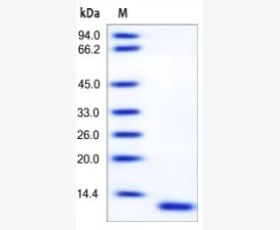Recombinant Human β-Defensin 4/DEFB4
| Product name: | Recombinant Human β-Defensin 4/DEFB4 |
| Source: | E.coli |
| Purity: | Greater than 95% as determined by reducing SDS-PAGE. |
| Buffer Formulation: | Lyophilized from a 0.2 μm filtered solution of 20mM PB, 130mM NaCl, pH 7.4. |
| Applications: | Applications:SDS-PAGE; WB; ELISA; IP. |
| Storage: | Avoid repeated freeze/thaw cycles. Store at 2-8 oC for one month. Aliquot and store at -80 oC for 12 months. |
| UOM: | 100ug/50ug/200ug/1mg/1g |
| Source | E.coli |
| Description | Recombinant Human beta-Defensin 4 is produced by our E.coli expression system and the target gene encoding Glu23-Pro72 is expressed. |
| Names | Beta-Defensin 104, Beta-Defensin 4, BD-4, DEFB-4, hBD-4, Defensin Beta 104, DEFB104A, DEFB104, DEFB4, DEFB104B |
| Accession # | Q8WTQ1 |
| Formulation | Lyophilized from a 0.2 μm filtered solution of 20mM PB, 130mM NaCl, pH 7.4. |
| Shipping |
The product is shipped at ambient temperature. |
| Reconstitution |
Always centrifuge tubes before opening. Do not mix by vortex or pipetting. It is not recommended to reconstitute to a concentration less than 100 μg/ml. Dissolve the lyophilized protein in ddH2O. Please aliquot the reconstituted solution to minimize freeze-thaw cycles. |
| Storage |
Lyophilized protein should be stored at < -20°C, though stable at room temperature for 3 weeks. Reconstituted protein solution can be stored at 4-7°C for 2-7 days. Aliquots of reconstituted samples are stable at < -20°C for 3 months. |
| Purity |
Greater than 95% as determined by reducing SDS-PAGE. |
| Endotoxin | Less than 0.1 ng/µg (1 IEU/µg) as determined by LAL test. |
| Amino Acid Sequence |
EFELDRICGYGTARCRKKCRSQEYRIGRCPNTYACCLRKWDESLLNRTKP
|
| Background | Defensins are cationic peptides. It is an important ingredient of the innate immune system. β-defensins are expressed on some leukocytes and epithelial surfaces. Four human β-Defensins have been identified to date: BD-1, BD-2, BD-3 and BD-4. β-defensins contain a six-cysteine motif, they forms three intra-molecular disulfide bonds. β-defensins are also chemoattractant towards immature dendritic cells and memory T cells. The β-defensin proteins are expressed as the C-terminal portion of precursors; they are released by proteolytic cleavage of a signal sequence. |














